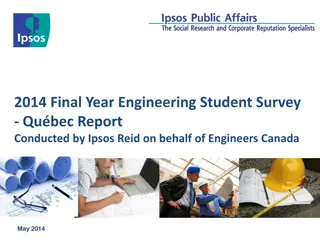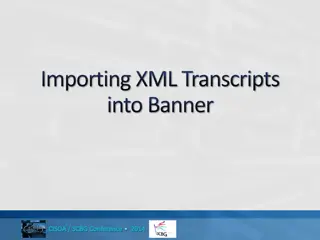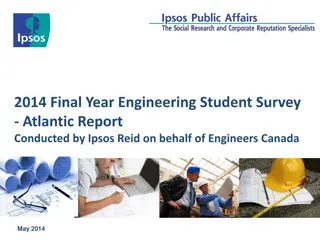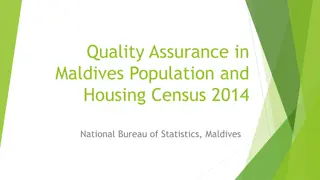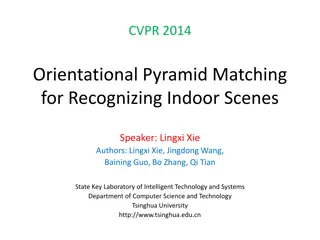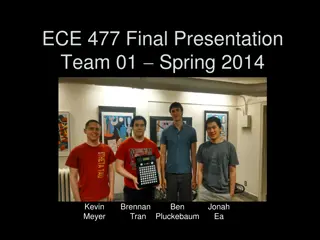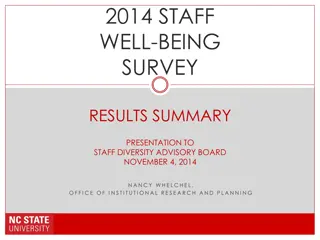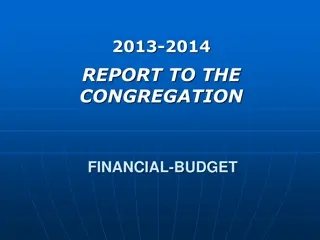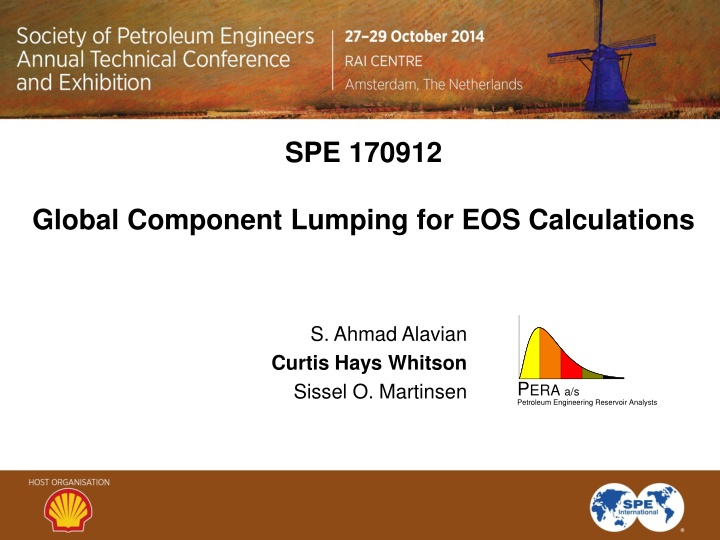
Component Lumping for EOS Calculations in Petroleum Engineering
"Learn about the process of component lumping for Equation of State (EOS) calculations in petroleum engineering to optimize phase and volumetric behavior. This approach reduces the number of components to describe pressure-temperature-composition spaces, essential for reservoir simulation, production tubing flow performance, and surface processing. Explore the methodology, validation steps, and comprehensive data analysis outlined in the paper for efficient EOS modeling." (Word count: 59)
Download Presentation

Please find below an Image/Link to download the presentation.
The content on the website is provided AS IS for your information and personal use only. It may not be sold, licensed, or shared on other websites without obtaining consent from the author. If you encounter any issues during the download, it is possible that the publisher has removed the file from their server.
You are allowed to download the files provided on this website for personal or commercial use, subject to the condition that they are used lawfully. All files are the property of their respective owners.
The content on the website is provided AS IS for your information and personal use only. It may not be sold, licensed, or shared on other websites without obtaining consent from the author.
E N D
Presentation Transcript
SPE 170912 Global Component Lumping for EOS Calculations S. Ahmad Alavian Curtis Hays Whitson Sissel O. Martinsen PERA a/s Petroleum Engineering Reservoir Analysts
Slide 2 Component Lumping Pseudoization Reduce number of components in an Equation of State (EOS) to a minimum for describing phase and volumetric behavior in a particular range of pressure-temperature-composition space for a particular engineering application. Reservoir simulation. Production tubing flow performance. Flowline networks. Surface processing. EOSxx EOSx Paper 170912 Global Component Lumping for EOS Calculations Curtis Whitson
Slide 3 Component Lumping How? 1. 2. 3. 4. 5. 6. 7. Start with a detailed EOSxx model e.g. xx=15-40. Choose total # of components in lumped EOSx model e.g. x=6-9. Choose which components to lump together e.g. N2 & C1. Choose a method to average EOS parameters e.g. Coats. Choose a composition to average EOS parameters e.g. zRi. Choose PVT calculations to validate EOSx e.g. ps, , , yi, xi. Compare EOSx versus EOSxx for same set of PVT calculations. Plots & Tables. Single-valued match quality metric SSQ, RMS If results are not good enough, go back to step 2. Paper 170912 Global Component Lumping for EOS Calculations Curtis Whitson
Slide 4 Component Lumping How We Do It 1. 2. 3. 4. 5. 6. 7. Start with a detailed EOSxx model e.g. XX=15-40. Choose total # of components in lumped EOSx model e.g. X=6-9. Choose which components to lump together try them all . Choose a method to average EOS parameters e.g. Coats. Choose a composition to average EOS parameters e.g. zRi. Choose PVT calculations to validate EOSx comprehensive. Compare EOSx versus EOSxx for same set of PVT calculations. Single-valued quality metric RMS. Final-pass assessment of best-RMS EOSx models. MMP | Plots & Tables. 8. Paper 170912 Global Component Lumping for EOS Calculations Curtis Whitson
Slide 5 All Lumping Combinations 1. EOSxx to EOSx possible combinations. e.g. xx=22 | x=9 ???! (??? ??)! 180,000,000,000 ?????= 2. Contiguous lumping constraint (neighboring EOSxx components). ( Nxx 1)! ( Nxx Nx)!( Nx 1)! 203,490 N????= 3. Algorithm to setup each scenario: Yukihiro Matsumoto (www). 4. Partial lumping not allowed e.g. 80% C3 in C3C4, 20% C3 in C3C5. 5. Optional forced lumpings e.g. N2+C1 , C30+ alone. Paper 170912 Global Component Lumping for EOS Calculations Curtis Whitson
Slide 6 Comprehensive p-T-z Data Validation 1. Range of feed compositions (GORs). 2. Range of PVT types ps, , , Vro, yi, xi, 3. Range of PVT tests depletion, gas injection, gradient, MMP. 4. Calculated once with EOSxx. 5. Calculated for each EOSx lumped scheme. 6. Final MMP validation i.e. long-running calculations for only select group of EOSx models. Paper 170912 Global Component Lumping for EOS Calculations Curtis Whitson
Slide 7 EOSx versus EOSxx 1. RMS quality metric of EOSx vs EOSxx. 0.5 ?????(????)2 ??????? ?=1 ?=1 ??? = ? = 2 rn=100 (dx,n - dxx,n) / dref,n. (dref) taken as max of all dxx data of a given type (e.g. oil density) in a given simulated lab test (e.g. CCE). 2. Optional MMP comparison of few EOSx models with lowest RMS. Paper 170912 Global Component Lumping for EOS Calculations Curtis Whitson
Slide 8 Lumping Examples Detailed EOSxx (xx=34) | Lumped EOSx (x=15, 9, 6) Peng-Robinson EOS (LBC) models. EOSxx components. N2& CO2 C1, C2, C3, i-C4, n-C4, i-C5, n-C5 C6C7C8... C28C29and C30+ Five fluids from a isothermal gradient used in PVT calculations. Lean gas condensate (OGR = 50 STB/MMscf) Richer gas condensate (OGR = 100 STB/MMscf) Near- critical oil (GOR = 5000 scf/STB)* Less-volatile oil (GOR = 2200 scf/STB) More-volatile oil (GOR = 1000 scf/STB) * Averaging sample. Paper 170912 Global Component Lumping for EOS Calculations Curtis Whitson
Slide 9 PVT Calculations & Weighting Experimental Property Weighting Factor Depletion and Multi-stage Separator Tests Saturation Pressure Liquid Volumes/Bo Liquid Saturation Liquid Density Gas-Oil Ratio Condensate-Gas Ratio Relative Volume Gas Specific Gravity Gas Density Gas Z-factor Liquid API Liquid Viscosity Gas Viscosity Swelling Experiment & CCE of Swollen Mixtures Saturation Pressure Liquid Saturation Relative Volume Liquid Density Gas Density Gas Z-factor Liquid Viscosity Gas Viscosity Some individual data may be weighted slightly different than the global default weighting factors given in this table. See the PhazeComp output file for exact weighting factors of data. 10 3 3 2 2 2 1 1 1 1 1 0 0 3 3 1 1 0.5 0.5 0 0 Paper 170912 Global Component Lumping for EOS Calculations Curtis Whitson
Slide 10 Lumping Example EOS9 EOS9 lumping constraints. 3 single components: N2, CO2and C1 Lumping starts from C2. 6 Lumped components. 142,506 total lumping scenarios. All scenarios performed (without including MMP calculation). 500 best-RMS scenarios selected, including MMP calculation. Paper 170912 Global Component Lumping for EOS Calculations Curtis Whitson
Slide 11 Paper 170912 Global Component Lumping for EOS Calculations Curtis Whitson
Slide 12 Best scenario with MMP Local Minima Best scenario without MMP Local Minima Paper 170912 Global Component Lumping for EOS Calculations Curtis Whitson
Slide 13 Best Five with Lowest RMS Local Minima RMS Best MMP Case no. RMS (%) MMP (psia) 3660 35846 1.270 3585 -2.0% N2 CO2 C1 C2_C3 I-C4_C7 35833 1.294 3587 -2.0% N2 CO2 C1 C2_C3 I-C4_C7 35832 1.300 3589 -1.9% N2 CO2 C1 C2_C3 I-C4_C7 35860 1.313 3582 -2.1% N2 CO2 C1 C2_C3 I-C4_C7 C8_C10 35847 1.265 3583 -2.1% N2 CO2 C1 C2_C3 I-C4_C7 C8_C10 C8_C10 C8_C10 C8_C10 C11_C15 C11_C15 C11_C14 C11_C14 C11_C16 C16_C25 C16_C24 C15_C25 C15_C24 C17_C25 C26_C30+ C25_C30+ C26_C30+ C25_C30+ C26_C30+ C24_C30+ C26_C30+ C24_C30+ 53395 1.387 3544 -3.2% N2 CO2 C1 C2_I-C4 N-C4_C7 C8_C10 C11_C15 C16_C23 12074 1.793 3552 -2.9% N2 CO2 C1 C2 C3_N-C5 C6_C10 C11_C16 C17_C25 34458 1.683 3661 0.0% N2 CO2 C1 C2_C3 I-C4_C6 C7_C11 C12_C15 C16_C23 Paper 170912 Global Component Lumping for EOS Calculations Curtis Whitson
Slide 14 Near-Critical Oil Paper 170912 Global Component Lumping for EOS Calculations Curtis Whitson
Slide 15 Lean Gas Condensate Paper 170912 Global Component Lumping for EOS Calculations Curtis Whitson
Slide 16 Paper 170912 Global Component Lumping for EOS Calculations Curtis Whitson
Slide 17 Conclusions 1. The lumping method is designed to describe a particular engineering discipline (reservoir, flow assurance, process facilities) for which the lumped EOSx is being applied. Different EOSx models may be developed for each modling discipline from same EOSxx model ensures consitency. 2. The method uses a well-defined quantitative measure of the lumped EOSx model accuracy in terms of how well the PVT compare with the original detailed EOSxx model. 3. The lumping method makes a comprehensive search of all possible lumping scenarios with few but meaningful constraints. Paper 170912 Global Component Lumping for EOS Calculations Curtis Whitson
Slide 18 Conclusions 4. The challenge in applying the proposed lumping method is a. Defining an appropriate set of PVT calculations for defining the quality metric for the processes being modeled with EOSx. b. Defining weighting factors for each data to reflect their importance to the processes being modeled with EOSx. c. Automated execution of all EOSx scenarios (Pipe-It) using a fast and robust EOS-based PVT program (PhazeComp). Paper 170912 Global Component Lumping for EOS Calculations Curtis Whitson
Slide 19 Thank You



